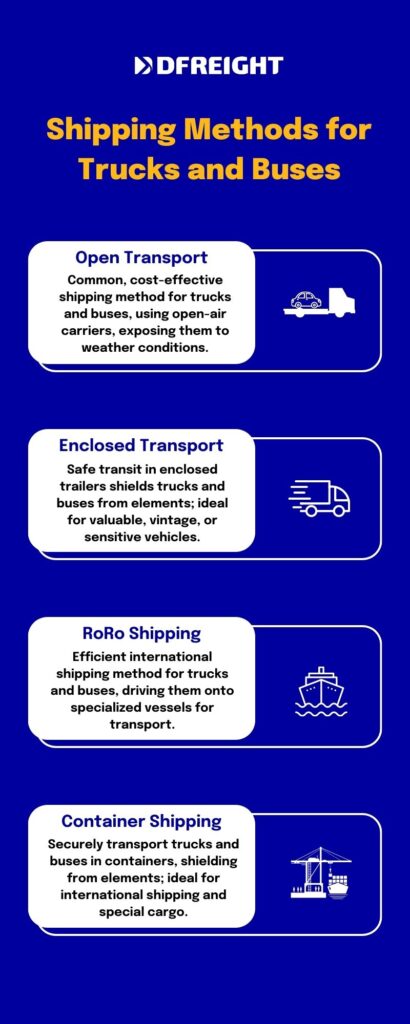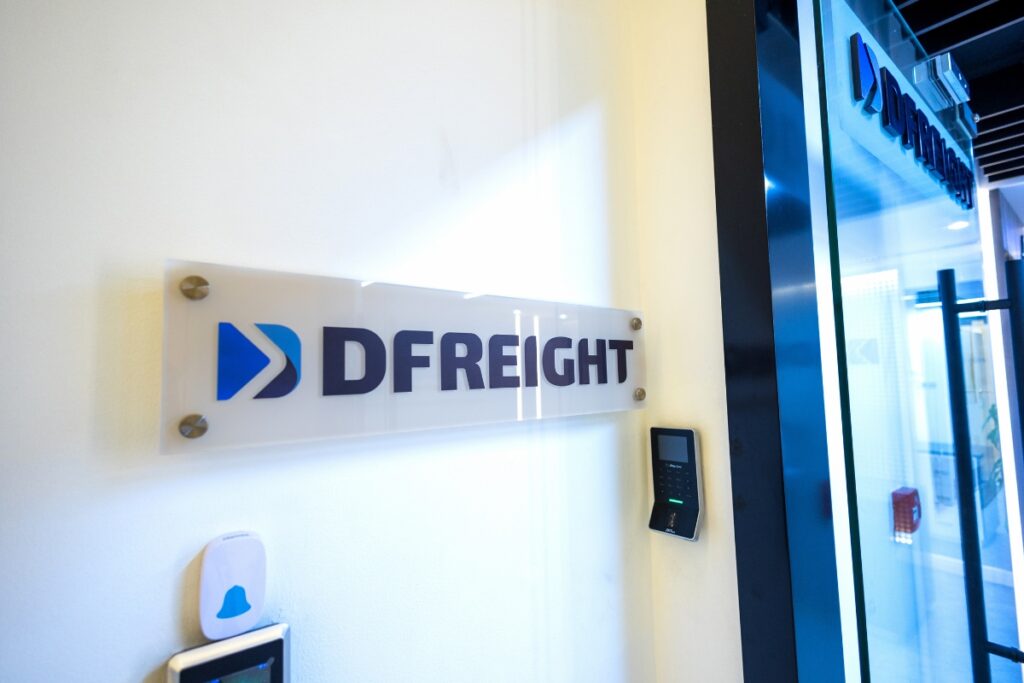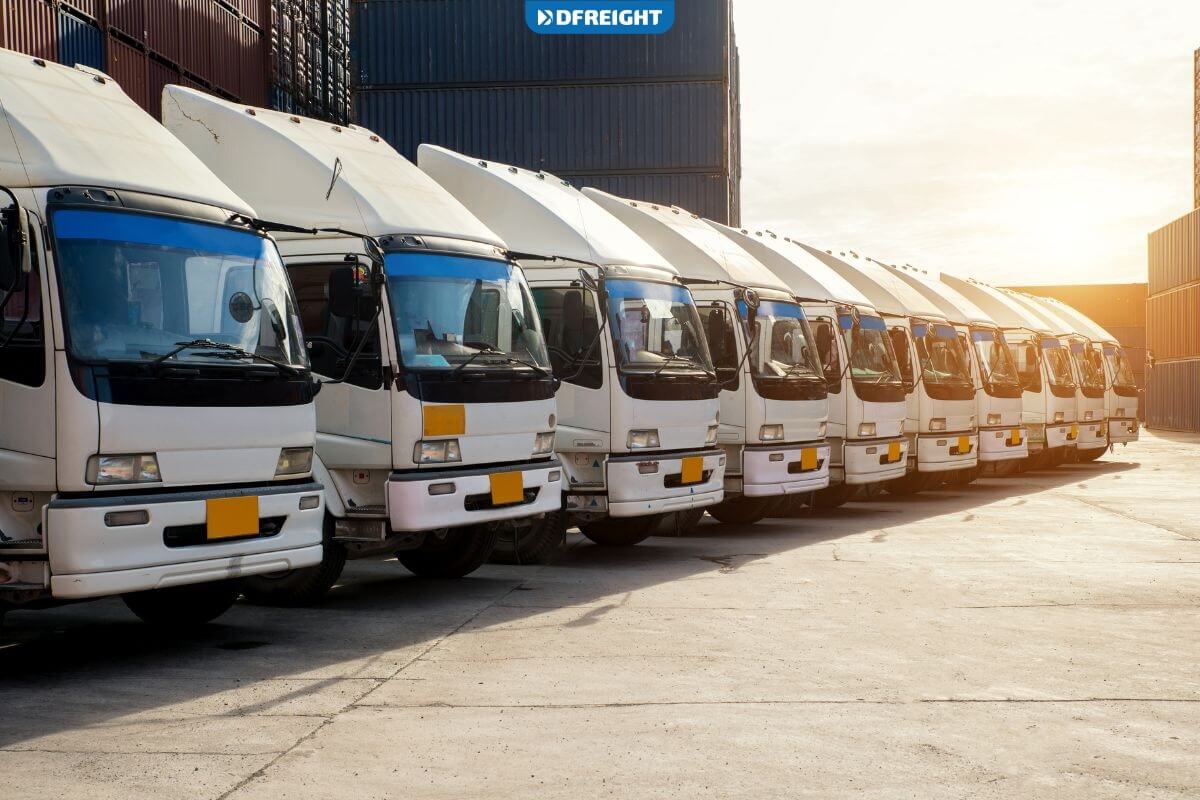Shipping trucks and buses is a critical process that plays a vital role in various industries, from logistics and construction to public transportation and tourism. Whether you are a business owner needing to move commercial vehicles to a new location or an individual relocating your cherished bus, understanding the ins and outs of truck and bus shipping is essential to ensure a smooth and successful transportation experience.
Choose DFreight as your digital freight forwarder, and experience the convenience of modern shipping logistics. Embrace the power of technology, streamline your business, and trust our expertise in shipping trucks and buses. Join our growing community of satisfied customers and let DFreight redefine the way you ship goods.
Shipping trucks and buses can be daunting, and we understand the importance of a well-informed decision-making process. As such, we will provide invaluable tips and insights to help you make the best choices at each stage of the shipping journey. Throughout this guide, we will explore the key considerations when choosing a reliable auto shipping company, understanding the factors influencing shipping costs. Whether you are shipping within the same country or venturing into international territories, we will also delve into the unique considerations associated with overseas shipping.
Table of Contents
Types of Trucks and Buses for Shipping
When it comes to shipping trucks and buses, there is a wide array of vehicle types available, each serving different purposes and industries. Understanding the classifications and considerations for each class is essential for selecting the most appropriate shipping method and ensuring a smooth transportation process. Here are the main types of trucks and buses commonly shipped:
Trucks
- Light Duty Trucks: Light-duty trucks, such as pickup trucks and small delivery vans, are often used for personal and commercial purposes. They are typically designed for transporting goods and equipment over short distances. Light-duty trucks are popular for local shipments and may require less specialized shipping methods due to their size and weight.
- Medium Duty Trucks: Medium-duty trucks strike a balance between light-duty and heavy-duty trucks. These vehicles are commonly used for regional transportation and commercial deliveries. They have a higher payload capacity and are suitable for hauling larger loads, making them a common sight on highways and city streets.
- Heavy Duty Trucks: Heavy-duty trucks are the workhorses of the transportation industry. They are built to handle heavy loads and long-haul journeys, making them crucial for long-distance freight transportation. These trucks are often used for transporting goods and materials across the country and are equipped with powerful engines to handle the demands of such extensive travel.
- Specialized Trucks: Specialized trucks cater to specific industries and tasks. Examples include refrigerated trucks for transporting perishable goods, tanker trucks for liquids or chemicals, and flatbed trucks for oversized or irregularly shaped cargo. Shipping specialized trucks may require unique considerations and customized transportation solutions.
Buses
- City Buses: City buses, also known as transit buses or public transport buses, are designed for urban transportation. They play a crucial role in public transit systems, providing reliable transportation for commuters within cities and metropolitan areas. City buses come in various sizes and configurations, accommodating different passenger capacities.
- Coach Buses: Coach buses, often called intercity or tour buses, are designed for long-distance travel and comfort. These vehicles, such as tourism, charters, and interstate transportation, are commonly used for group travel. Coach buses feature amenities like reclining seats, restrooms, and entertainment systems to ensure a pleasant journey for passengers.
- School Buses: School buses are dedicated to transporting students to and from educational institutions. They prioritize safety with features like stop signs, flashing lights, and reinforced bodies. While some school buses are small and compact, others can be larger and capable of carrying more students.
- Minibuses: Minibuses are smaller versions of standard buses for shuttle services, airport transfers, and small-group transportation. They offer greater flexibility for navigating narrow roads and are ideal for short-distance trips.
When shipping trucks and buses, it is essential to consider the unique characteristics of each vehicle type. Factors such as size, weight, and fragility will influence the choice of shipping method, ensuring the safe and efficient delivery of these valuable assets to their intended destinations.
Choosing the Right Shipping Method
Selecting the appropriate shipping method for trucks and buses is a crucial decision that significantly impacts the transportation process’s safety, cost, and efficiency. Several factors come into play when making this choice, and it’s essential to consider the specific requirements of your vehicles and shipping needs. Here are the main shipping methods available for trucks and buses:

Open Transport
Open transport is the most common and cost-effective method for shipping trucks and buses. It involves transporting vehicles on an open-air carrier, much like the ones used to transport new cars to dealerships. The vehicles are exposed to the elements during transit, including weather conditions like rain, dust, and debris. Open transport is suitable for standard trucks and buses without special requirements or exposure concerns.
Enclosed Transport
Enclosed transport offers maximum protection for trucks and buses during transit. Vehicles are transported in an enclosed trailer, protecting them from external elements and potential damage. This method is ideal for shipping valuable, vintage, or luxury trucks and buses, as well as those that require additional protection due to their sensitivity to weather or road debris. While enclosed transport offers higher security, it may be more expensive than open transport.
Roll-on/Roll-off (RoRo) Shipping
RoRo shipping involves driving trucks and buses onto a specialized vessel accommodating wheeled cargo. Once onboard, the vehicles are lashed and transported to the destination port. This method is commonly used for international shipping, especially for large quantities of vehicles. It is efficient and cost-effective for transporting trucks and buses between ports.
Container Shipping
Container shipping involves placing trucks and buses inside a shipping container for transportation. The container offers protection against external elements and provides additional security of shipments during transit. It is commonly used for international shipping, mainly when vehicles must be transported across long distances or regions with varying weather conditions. Container shipping is suitable for specialized vehicles, high-value cargo, or when multiple vehicles need to be shipped together.
Factors to Consider when Choosing the Right Shipping Method
- Distance: The distance to be covered plays a significant role in choosing the shipping method. Long-distance or international shipping may require more protection and security, making enclosed transport or container shipping more suitable.
- Vehicle Type: The size, weight, and specifications of the truck or bus are crucial considerations. Specialized vehicles, luxury buses, or valuable trucks may require the added protection of enclosed transport or container shipping.
- Budget: Your budget will also influence your choice of shipping method. Open transport is generally more budget-friendly, while enclosed transport and container shipping come with higher costs.
- Delivery Timeframe: If you have a specific deadline for receiving the vehicles, consider the transit time for each shipping method. RoRo and open transport often have quicker turnaround times compared to container shipping.
- Special Requirements: If your vehicles have specific handling or loading requirements, such as low ground clearance or disabled functionality, communicate these details with the shipping company to ensure they can accommodate them.
By carefully evaluating these factors and understanding the benefits and limitations of each shipping method, you can confidently choose the most suitable option for shipping your trucks and buses, ensuring a successful and smooth transportation process from start to finish.
Preparing Trucks and Buses for Shipping
Properly preparing your trucks and buses for shipping is essential to ensure their safe transit and protect them from potential damage during transportation. Taking the time to follow these preparation steps will help to minimize risks and make the shipping process more efficient. Here are the key steps to prepare your vehicles for shipping:
- Inspection and Documentation: Start by conducting a thorough inspection of each truck and bus before shipping. Note any existing damage, scratches, dents, or mechanical issues. Taking photos or videos can serve as documentation in case of any disputes later on. Prepare all the necessary documentation, including vehicle registration, insurance papers, and any special permits required for shipping. Make copies of these documents and keep them easily accessible during transportation.
- Cleaning and Removing Personal Belongings: Clean the interior and exterior of each vehicle to remove dirt and debris. A clean vehicle makes it easier to inspect for damages and ensures a professional appearance upon delivery. Remove all personal belongings from the trucks and buses. This includes any loose items, tools, and personal possessions. Shipping companies usually do not allow personal belongings inside vehicles during transportation.
- Securing Loose Parts and Accessories: Secure or remove any loose parts or accessories that could detach during transit. This includes side mirrors, antennas, spoilers, or detachable exterior items. Properly fasten or pack these items to prevent damage or loss.
- Dealing with Fluids and Hazardous Materials: Ensure that the fuel tank is not completely full but has enough fuel for loading and unloading purposes. A quarter tank of fuel is generally recommended. Check for leaks in the engine, transmission, or any other fluid systems. Repair any leaks before shipping to avoid potential damage to other vehicles or the shipping carrier.
- Disable Alarms and Automatic Systems: If your trucks or buses have car alarms or anti-theft systems, ensure they are disabled before shipping. Continuous alarms during transit can be a nuisance and drain the vehicle’s battery.
- Securing Doors and Windows: Close and lock all doors, windows, and hatches securely. Use zip ties or tape to secure doors that swing open during transit.
- Tire Maintenance: Check the tire pressure and ensure all tires are properly inflated. Proper tire maintenance reduces the risk of damage and provides smooth transportation.
- Battery and Electrical System: Disconnect the vehicle’s battery or, if not possible, ensure it is fully charged. Disconnecting the battery prevents accidental power drain during transit.
- Provide Detailed Instructions: If there are any specific instructions or requirements for loading or unloading your vehicles, provide them to the shipping company. Clear communication ensures that the process runs smoothly and minimizes the risk of mishaps.
By following these steps and adequately preparing your trucks and buses for shipping, you can have peace of mind knowing that your vehicles are ready for a secure and problem-free transportation experience. Additionally, it helps ensure that the shipping process is efficient and that your trucks and buses arrive at their destination in the best possible condition.
Choosing a Reliable Auto Shipping Company
Selecting a trustworthy auto shipping company is crucial to ensure a smooth and hassle-free transportation experience for your trucks and buses. With numerous options available, conducting thorough research and considering several factors before deciding is essential. Here are some critical steps to choose a reliable auto shipping company:
- Research and Reputation: Start by researching various auto shipping companies online. Look for customer reviews, testimonials, and ratings to gauge the company’s reputation and track record. Check if the company is registered with the Federal Motor Carrier Safety Administration (FMCSA) and has the necessary licenses and insurance for transporting vehicles.
- Experience and Expertise: Consider the experience of the auto shipping company in handling trucks and buses. An experienced company will likely have the expertise and knowledge required to deal with various types of vehicles and shipping challenges.
- Services Offered: Assess the services offered by the shipping company. Do they provide both open and enclosed transport options? Can they accommodate international shipping if needed? Ensure the company provides the specific services you require for your trucks and buses.
- Transparent Pricing: Obtain detailed quotes from multiple auto shipping companies. Look for transparent pricing without hidden fees or charges. Compare the quotes, but remember that the cheapest option may not always be reliable.
- Insurance Coverage: Verify the insurance coverage offered by the shipping company. Your vehicles should be protected in case of any damage or accidents during transit. Understand the insurance terms and conditions to ensure they meet your requirements.
- Customer Support and Communication: Evaluate the level of customer support provided by the company. A reliable auto-shipping company should be responsive and able to address your queries promptly. Clear communication is vital throughout the shipping process, so ensure the company maintains open lines of communication.
- Licensing and Certifications: Confirm that the shipping company has all the necessary licenses and certifications to operate legally in the transportation industry. Check if they are affiliated with reputable industry organizations, which can signify their commitment to professionalism.
DFreight, a Good Choice for Shipping Trucks and Buses
DFreight is a reputable digital freight forwarder that offers innovative and reliable shipping solutions. As a digital freight forwarder, DFreight leverages technology to streamline the shipping process, providing customers with a seamless and efficient experience. Here are some reasons why DFreight can be an excellent choice for shipping trucks and buses:
- Advanced Technology: DFreight’s cutting-edge technology platform allows for easy booking, tracking, and management of shipments online. This digital approach simplifies the shipping process and provides real-time visibility into the status of your vehicles.
- Industry Experience: DFreight has experience in handling various types of cargo, including trucks and buses. Their expertise ensures that your vehicles are transported safely and efficiently.
- Global Shipping: DFreight offers international shipping services, making them a reliable choice for transporting trucks and buses across borders.
- Insurance Coverage: DFreight provides comprehensive insurance coverage for cargo, giving you peace of mind knowing that your vehicles are protected throughout the shipping journey.
- Transparent Pricing: DFreight offers transparent pricing with no hidden fees, allowing you to budget accurately for the shipping costs.
- Customer Support: DFreight’s customer support team is responsive and available to assist you with any inquiries or concerns during shipping.

Overall, choosing DFreight as your digital freight forwarder can be a smart choice for shipping trucks and buses, as it combines the convenience of technology with the reliability of an experienced shipping partner. Our commitment to transparency, customer support, and efficient shipping services makes them a reliable option for your transportation needs.
Understanding Shipping Costs and Pricing Factors
Understanding shipping costs and pricing factors is crucial for making informed decisions when shipping trucks and buses. The total shipping cost is influenced by a combination of factors, including the type of vehicles being transported, the shipping distance, the chosen shipping method (open, enclosed, RoRo, or container), the weight and dimensions of the vehicles, and any additional services required, such as door-to-door delivery or expedited shipping.
Additionally, international shipments may incur customs duties, taxes, and import/export fees. By comprehending these pricing factors, individuals and businesses can effectively budget for shipping expenses and choose the most cost-effective and suitable shipping options.
The Shipping Process: From Pickup to Delivery
The shipping process for trucks and buses involves a series of well-coordinated steps from pickup to delivery, ensuring a smooth and efficient transportation journey.
It begins with scheduling the pickup date, where the shipping company collects the vehicles from the specified location. Upon pickup, a thorough inspection is conducted to assess the condition of the trucks and buses before loading them onto the chosen transportation carrier, whether it’s an open trailer, enclosed carrier, RoRo vessel, or shipping container.
During transit, real-time tracking and communication inform clients about their vehicles’ whereabouts and estimated arrival times. Upon reaching the destination, another inspection ensures the vehicle’s condition matches the pre-shipping assessment.
Finally, the trucks and buses are delivered to the designated address, completing the shipping process and providing customers with their vehicles in the best possible condition.
International Shipping Considerations
International shipping considerations are vital when transporting trucks and buses across borders. The process involves navigating complex customs regulations, import/export taxes, and duties in different countries. Proper documentation, including vehicle titles, certificates of origin, and customs declarations, is essential for smooth clearance through customs. Selecting the appropriate shipping method, whether RoRo, container shipping, or air freight, is crucial to ensure the vehicles’ safe and timely arrival.
Additionally, being aware of international shipping restrictions and requirements for specific vehicle types is essential to avoid delays or complications during transit. By understanding these considerations, shippers can effectively plan and execute successful international shipments, ensuring that trucks and buses reach their destinations without unnecessary hurdles.
Conclusion
In conclusion, shipping trucks and buses require careful planning, preparation, and consideration of various factors. From selecting the suitable shipping method to adequately preparing the vehicles for transit, each step plays a crucial role in ensuring a successful transportation experience. Shippers can budget effectively and make informed decisions by choosing a reliable auto shipping company, like DFreight, and understanding the pricing factors involved. Moreover, staying vigilant about the shipping process from pickup to delivery and being mindful of international shipping considerations is essential for a smooth and efficient journey, whether within the country or across borders.
Armed with the knowledge and insights provided in this ultimate guide, individuals and businesses can confidently navigate the complexities of shipping trucks and buses, ultimately safeguarding their valuable assets and ensuring a seamless transportation process from start to finish. With careful planning and attention to detail, shipping trucks and buses can be stress-free and successful.
What are the main types of trucks and buses commonly shipped?
Trucks include light-duty, medium-duty, heavy-duty, and specialized trucks, while buses encompass city, coach, school, and minibuses.
How do I choose the right shipping method for my trucks and buses?
Consider factors such as distance, vehicle type, budget, and delivery timeframe. Options include open transport, enclosed transport, RoRo shipping, and container shipping.
How can I prepare my trucks and buses for shipping?
Conduct a thorough inspection, clean the vehicles, secure loose parts, deal with fluids, disable alarms, and ensure tires and batteries are in good condition.
What are the pricing factors that influence shipping costs?
Shipping costs depend on vehicle type, shipping method, distance, weight, dimensions, and any additional services required, such as expedited delivery or international customs fees.
What are the considerations for international truck and bus shipping?
International shipping involves navigating customs regulations, import/export taxes, and duties. Proper documentation, selecting the right shipping method, and being aware of international shipping restrictions are essential for a successful transit.














